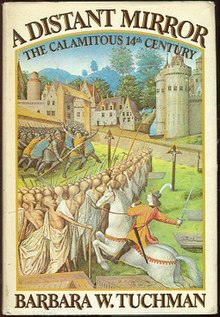《遠方之鏡:動盪不安的十四世紀》(A Distant Mirror, 1978 台北:廣場,2018)
比較頁316查理五世的圖書與 與Wikipedia 的Charles V (21 January 1338 – 16 September 1380), called "the Wise" (French: le Sage; Latin: Sapiens), was King of France from 1364 to his death,.... 之culture program:
比較頁316查理五世的圖書與 與Wikipedia 的Charles V (21 January 1338 – 16 September 1380), called "the Wise" (French: le Sage; Latin: Sapiens), was King of France from 1364 to his death,.... 之culture program:
遠方之鏡:動盪不安的十四世紀
A Distant Mirror The Calamitous 14th Century
- 作者: 芭芭拉‧塔克曼
- 原文作者: BARBARA W. TUCHMAN
- 譯者: 邵文實
- 出版社:廣場出版 新功能介紹
- 出版日期:2018/03/21
作者介紹
目錄
 | |
| Author | Barbara Tuchman |
|---|---|
| Country | United States |
| Language | English |
| Published | Alfred A. Knopf, 1978 |
| Media type | Print (paperback, hardcover) |
| Awards | National Book Award, 1980 |
| ISBN | 978-0-345-34957-6 |
A Distant Mirror: The Calamitous 14th Century is a narrative history book by the American historian Barbara Tuchman, first published by Alfred A. Knopf in 1978. It won a 1980 U.S. National Book Award in History.[1][a] The main title, A Distant Mirror, conveys Tuchman's idea that the death and suffering of the 14th century reflect that of the 20th century, especially the horrors of World War I.
Summary[edit]
The book's focus is the Crisis of the Late Middle Ages suffered by Europe in the 14th century. Drawing heavily on Froissart's Chronicles, Tuchman recounts the Hundred Years' War, the Black Plague, the Papal Schism, pillaging mercenaries, anti-Semitism, popular revolts including the Jacquerie in France, the liberation of Switzerland, the Battle of the Golden Spurs, and peasant uprisings. She also discusses the advance of the Islamic Ottoman Empire into Europe, ending in the disastrous Battle of Nicopolis. Yet Tuchman's scope is not limited to political and religious events. She begins with a discussion of the Little Ice Age, a change in climate that reduced the average temperature of Europe until the 18th century, and describes the lives of all social classes, from nobles and clergymen to the peasantry.
Much of the narrative is woven around the life of the French nobleman Enguerrand de Coucy. Tuchman chose him as a central figure partly because he lived a relatively long life and could therefore stay in the story during most of the 14th century. (Coucy was born in 1340, seven years before the Black Death began in southern Italy. He died in 1397.) He was also close to much of the action, tied to both France and England. (Coucy was a French noble but he married Isabella, the eldest daughter of Edward III of England.)
Critical reception[edit]
A Distant Mirror received much popular acclaim. A reviewer in the monthly history magazine History Today described it as an enthralling work full of "vivid pen-portraits."[2] In The Spectator, David Benson called it "an exciting and even bracing" book which did away with many sentimental myths about the Middle Ages.[3] It also received a favorable review in the Los Angeles Times,[4] though in the Saturday Review, Ted Morgan described it as a "noble failure."[5]
However, scholarly reaction was more muted. In the journal Speculum, Charles T. Wood praised Tuchman's narrative abilities but described the book as a "curiously dated and old-fashioned work" and criticized it for being shaped by the political concerns of the United States in the late 1960s and early 1970s.[6] Bernard S. Bachrach criticized Tuchman's reliance on secondary sources and dated translations of medieval narratives at the expense of archival research, and characterized the book as a whole as "a readable fourteenth-century version of the Fuzz n' Wuz (cops and corpses) that dominates the evening news on television."[7] Thomas Ohlgren agreed with many of Bachrach's criticisms, and further took issue with many perceived anachronisms in Tuchman's characterization of the medieval world and a lack of scholarly rigor.[8] William McNeill, writing in the Chicago Tribune, thought that A Distant Mirror, while well-written on a technical level, didn't present an intelligible picture of the period.[9]
沒有留言:
張貼留言